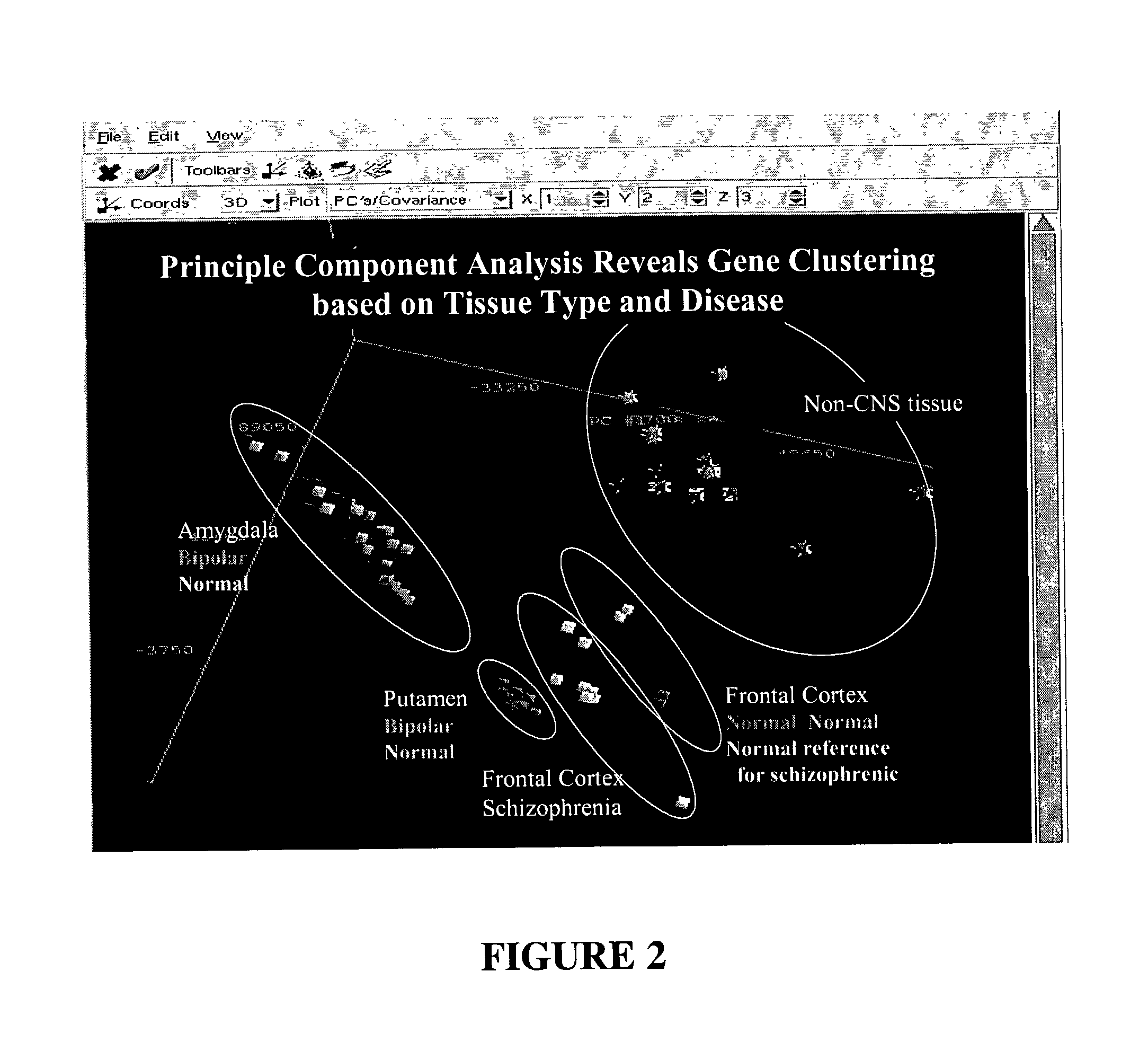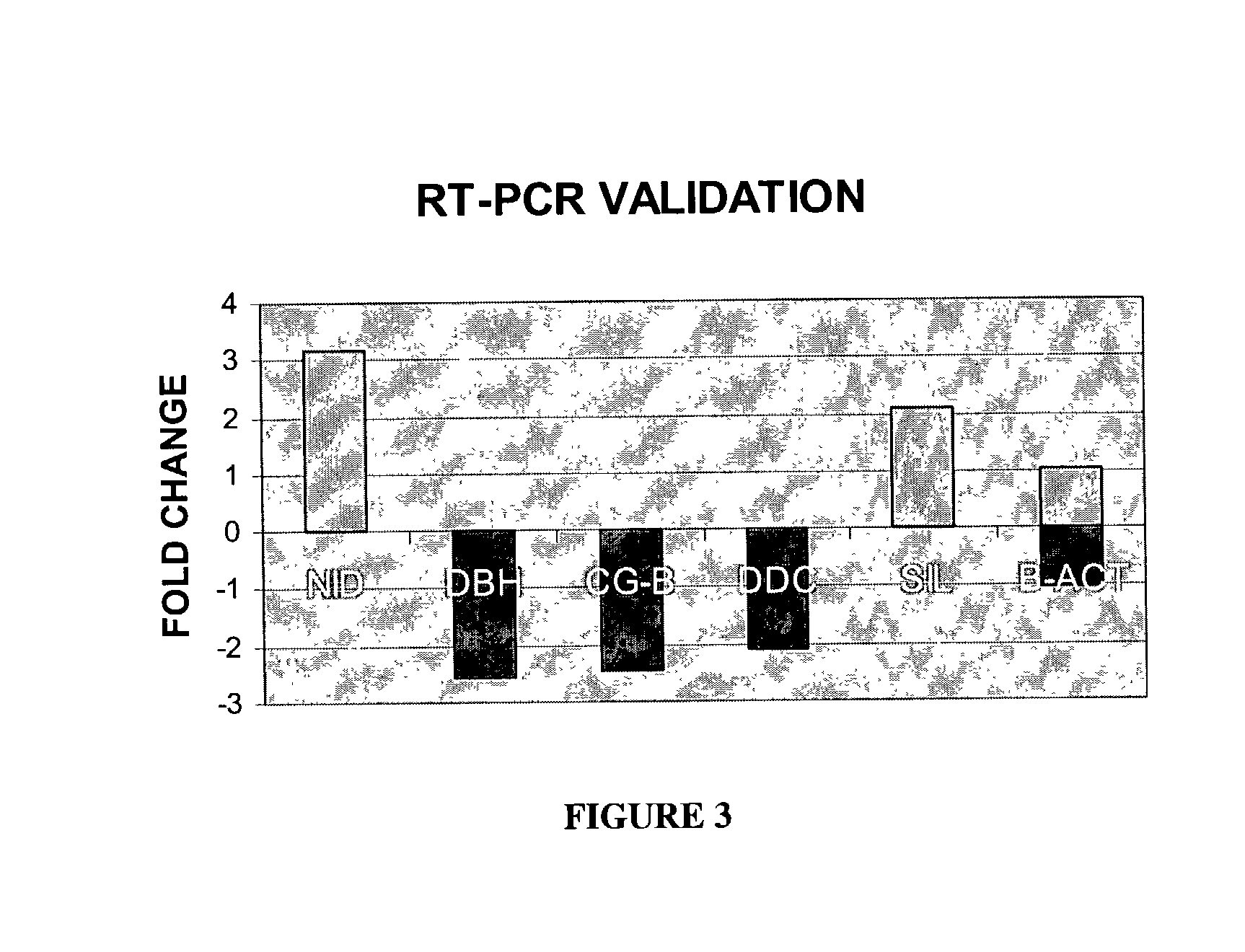Multi-parameter high throughput screening assays (MPHTS)
a high throughput, multi-parameter technology, applied in the field of screening methods, can solve the problems of confounded efforts to identify and understand the molecular nature of neuropsychiatric disorders, traditional genetic methods such as linkage analysis, and less successful in identifying genes involved in neuropsychiatric disorders
- Summary
- Abstract
- Description
- Claims
- Application Information
AI Technical Summary
Benefits of technology
Problems solved by technology
Method used
Image
Examples
example 1
INDUCED CHANGES IN GENE EXPRESSION PROFILES
[0136] This example describes experiments, which analyzed changes in the expression profile for rat (rattus norvegicus) neuronal cells induced by valproate, a drug used clinically to treat neuropsychiatric disorders such as bipolar disorder. Expression levels for about 8500 genes were evaluated, and genes whose expression levels changed significantly in response to treatment with valproate were identified. Expression profiles for these genes are compared to expression profiles for orthologous genes in human schizophrenia patients. These data demonstrate that the genes are useful, e.g., for monitoring treatment and therapies for neuropsychiatric disorders (including treatments and therapies for disorders such as schizophrenia and bipolar disorder), as well as in screening methods that identify novel therapeutic compounds.
[0137] Primary neuron cells were isolated from E19 rat embryos and cultured as follows. First, the cortex was dissected fr...
example 2
ATION OF ADDITIONAL SIGNATURE GENES
[0148] In addition to the twelve genes described, supra, in Example 1, at least thirty additional genes were identified as signature genes that can be used, e.g., in MPHTS or other assays to identify new therapeutics for neuropsychiatric disorders (including therapeutics for specific neuropsychiatric disorders such as schizophrenia and bipolar disorder). These signature genes are also useful for monitoring such new and existing (i.e., known) therapies for such neuropsychiatric disorders.
[0149] The additional signature genes described here were identified using a human neuroblastoma cell line that is known in the art as NBFL (see, Symes et al., Proc. Natl. Acad. Sci. U.S.A. 1993, 90(2):572-576). NBFL cell cultures were maintained in DMEM medium supplemented with L-glutmine, antibiotics, 10% fetal bovine serum and 5% horse serum. Before treatment, cells were passaged, allowed to adhere overnight, and the medium was replaced with serum free medium for...
example 3
INDUCED CHANGES IN GENE EXPRESSION PROFILES IN VIVO
[0155] This example describes still other experiments in which signature genes were identified and / or confirmed by analyzing changes of expression profiles, in vivo.
[0156] Specifically, in these experiments rats were treated with valproate, and gene expression levels in the hippocampus of each rat were measured for a plurality of different genes.
[0157] In more detail, twenty rats were divided into two groups, containing ten individuals each. One group of ten rats was used as the control group, whereas the other group functioned as the experimental group. Each rat in the experimental group was injected twice daily with 250 mg valproate for each kilogram of the rat's body mass. Each rat in the control group was similarly injected, but with a vehicle that contained no active ingredient. After three weeks dosing, the rats were sacrificed and their brains removed. Each rat's brain was divided in half. The hippocampus was then removed fro...
PUM
| Property | Measurement | Unit |
|---|---|---|
| Length | aaaaa | aaaaa |
| Therapeutic | aaaaa | aaaaa |
| Disorder | aaaaa | aaaaa |
Abstract
Description
Claims
Application Information
 Login to View More
Login to View More - R&D
- Intellectual Property
- Life Sciences
- Materials
- Tech Scout
- Unparalleled Data Quality
- Higher Quality Content
- 60% Fewer Hallucinations
Browse by: Latest US Patents, China's latest patents, Technical Efficacy Thesaurus, Application Domain, Technology Topic, Popular Technical Reports.
© 2025 PatSnap. All rights reserved.Legal|Privacy policy|Modern Slavery Act Transparency Statement|Sitemap|About US| Contact US: help@patsnap.com



